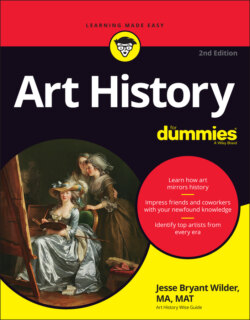Читать книгу Art History For Dummies - Jesse Bryant Wilder - Страница 89
Playing Puabi’s Lyre
ОглавлениеWhen a Sumerian king or queen died, he or she didn’t go to the grave alone. More than 60 soldiers, attendants, and musicians accompanied King Abargi of Ur into the tomb. Some of these grave guests wore helmets and carried spears to protect the king from any afterlife dangers; others bore musical instruments (including Puabi’s lyre, shown in Figure 5-2) to perform for him, and a few drove wagons, which were pulled by teams of oxen. The oxen’s remains were also found in the grave.
More than 20 attendants joined Queen Puabi in her nearby tomb, including three soldiers with drawn copper daggers and ten well-dressed women buried in two rows facing each other. Whether these tomb groupies committed mass suicide or soldiers simply slew them, historians don’t know. We do know that working for a Sumerian ruler was a demanding job!
The exquisite decoration that adorns Puabi’s lyre shows that Ur artists were master craftsmen. A golden bull’s head protrudes from the harp, which stands in for the bull’s body. His blue-tipped horns, mat of blue hair, baby blue eyes, and curlicue blue beard are made of lapis lazuli, an azure or deep-blue gemstone. Note: The closest source of lapis was 2,000 miles away in Afghanistan. Obviously, trade flourished in third-millennium Asia! Under the bull’s beard is a strip of animal fables wrought with wood and shell and inlaid in bitumen, a mineral pitch made from coal or oil.
gravure française/Alamy Stock Photo
FIGURE 5-2: The design on the front of Puabi’s lyre illustrates four ancient fables.
But who is the bull with the blue-tipped horns? In the Sumerian epic Gilgamesh (a story about literature’s first superhero), Gilgamesh and his friend Enkidu wrestle and slay the Bull of Heaven, whose horns are also made of lapis lazuli, like the bull’s head on the lyre. Closer examination of the lyre’s bands reveals these details:
The Gilgamesh motif: In the top band, a naked macho man hugs two bulls as though they were old school chums. The bulls’ faces practically mirror the man’s, and their right legs and hooves wrap about his head like parentheses. This image, common in Mesopotamian art, is sometimes called the “Gilgamesh motif.”
Visual stories or fables: The three other bands under the Gilgamesh motif tell a visual story or perhaps a series of fables invented long before Aesop. A lion, bear, wolf, deer, donkey, gazelle, and scorpion-man serve food and beverages or play instruments like the humanoid animals in Disney cartoons.
Some of the scenes in Puabi’s lyre must have seemed comic even then, like the ass playing the lyre or the wolf and lion waiters bearing food and drink for a feast. Ironically, the wolf, who wears a knife in his belt, carries a wolf’s head on a platter (it could be one of his cousins), which he apparently just dressed for dinner!
We can only guess at the meaning of the artwork today, ponder what appear to be ironies, and enjoy the craftsmanship of artists who lived four and half millennia before us.
